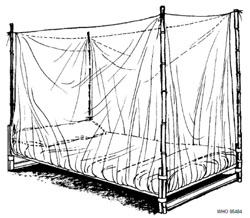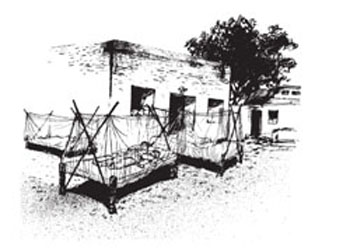11.3.1 Rectangular nets
The rectangular net (Figure 11.1) is normally used over a bed or sleeping mat. It is the model widely used in Ethiopia. It is suspended from four or more loops along the upper edges.

Dimensions vary: most nets have a height of about 150 cm and a length of 180–190 cm. A single-size net has a width of 70–80 cm, contains about 9 m2 of netting material and is used to cover one person on a single bed or sleeping mat. Double nets with a width of 100–110 cm (10–11 m2 of netting) and family-size or large double nets with a width of 130–140 cm (12–13 m2 of netting) are used for larger beds. The optimal size depends on sleeping habits and available space. All nets distributed in Ethiopia are family size nets.
Special supports for rectangular bed nets
Indoor supports: Where it is customary to rearrange and use beds for seating during daytime, nets should be supported using detachable poles or mosquito net supports attached to the ceiling or walls.
If possible children should go to sleep as early as possible indoors under nets; if they have to sleep outdoors they must sleep under nets.
Outdoor supports: In some villages where the climate is hot, people tend to sleep outdoors during the peak malaria season. People may also stay late outdoors working or chatting before going indoors to sleep. In many cases, people let their children sleep outdoors until the adults go indoors to sleep late at night. Where people usually sleep outdoors, or stay outdoors late into the night during the hot season, nets should be used outdoors. Outdoors, nets are best supported by a frame that can be easily detached from the bed (Figure 11.2). Most vectors of malaria bite people from sunset to dawn. To get full protection from the nets, people must use nets from dusk to dawn. If people stay late outdoors chatting, they should use the nets outdoors too. In particular, children should not be left to sleep outdoors without nets.

11.3 Mosquito net models
